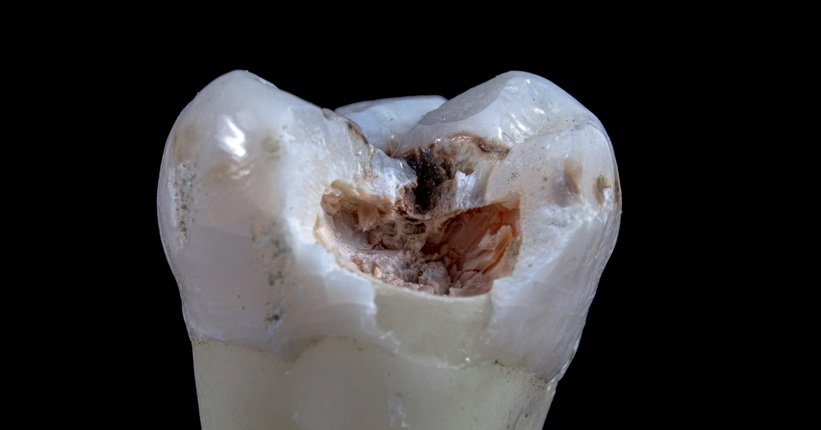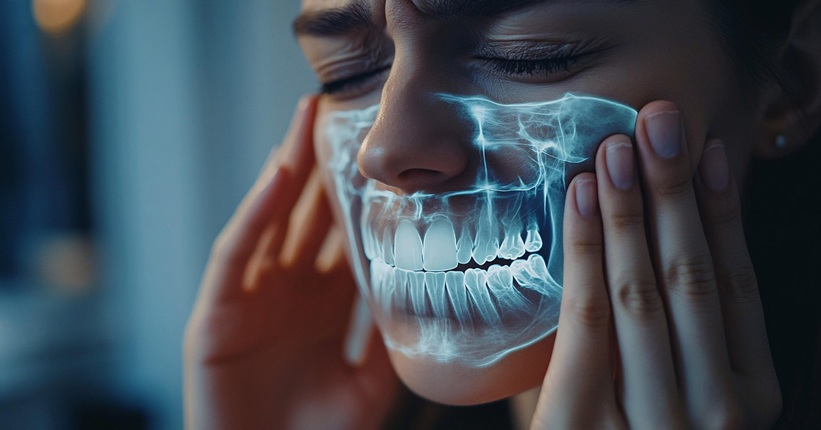
The beginnings of caries - how to recognize the first signs of caries?
Caries is one of the most common oral diseases that affects millions of people around the world. Although it can develop for a long time without pronounced symptoms, early detection of the problem is crucial for effective treatment. Understanding how to recognize the first signs of caries allows you to take measures that can prevent further damage to your teeth. With proper hygiene, healthy habits, and regular check-ups at the dentist, you can effectively fight tooth decay at an early stage. How to recognize the beginnings of caries before it develops into a more serious problem requiring the intervention of a dentist?
What is caries?
Tooth decay is a disease of the tooth tissues that leads to their gradual destruction. It is the result of the action of bacteria that live in the mouth and feed on sugars and other carbohydrates that we consume. These bacteria produce acids that destroy tooth enamel, which is the hard, outer layer that protects the tooth. Caries can lead to cavities in the teeth, and if not treated properly, they can reach deeper layers of the tooth, such as dentin or pulp, causing pain, infections, and, ultimately, the need to remove the tooth.
How is caries formed on teeth?
Caries is formed when acids produced by bacteria that accumulate in plaque begin to destroy the structure of the teeth. These bacteria stick to the surface of the teeth and form tartar, which acts as a protective barrier, allowing microbes to penetrate deep into the tooth. When you eat snacks between meals, and especially sweet foods, there is a decrease in pH in the mouth. Too acidic an environment inhibits the process of remineralization of enamel, that is, the restoration of its structure. As a result, minerals such as phosphorus, calcium, and potassium are washed out, which leads to demineralization and thus weakening of the enamel and the formation of cavities, that is, caries.
Stages of caries development
The development of caries proceeds in several stages, which can lead to more and more damage to the tissues of the tooth. Here are the main stages of caries development:
1. Origins of caries — demineralization of enamel
At this stage, the acids produced by bacteria in the plaque begin to wash out minerals (mainly calcium and phosphorus) from the enamel. White spots are formed on the surface of the tooth, which indicates the onset of demineralization. The enamel is still intact, but the process of its weakening has already begun.
2. Early decay in enamel
At this stage, the enamel is further weakened, and the demineralization process progresses. A small defect may appear in the surface of the tooth, which is still limited to the outer layer of enamel. At this stage, it is still possible to reverse the process thanks to remineralization, if proper oral hygiene is maintained and preventive measures are applied.
3. Loss in dentin
If the caries process is not stopped, the acids penetrate deeper, penetrating into the dentin, that is, the layer located under the enamel. Dentin is less hard than enamel, so it is more susceptible to damage. More pronounced cavities begin to appear, and the tooth becomes more prone to pain, especially in response to temperature changes (cold, hot).
4. Advanced tooth pulp defect
If the caries reaches the pulp of the tooth (the inner tissue containing nerves and blood vessels), severe pain occurs. At this stage, bacteria can trigger inflammation in the pulp, which leads to the need for root canal treatment or tooth extraction. The tooth can become very sensitive to stimuli, and the pain can be incessant.
5. Advanced infection and necrosis
If caries is not treated, bacteria can infect the pulp, leading to its death (necrosis). The tooth becomes dead, which can lead to the formation of an abscess and, in the worst case, to the loss of the tooth.
Each of these steps can be reversed or slowed down to some extent with proper oral hygiene, the use of fluoride pastes, and regular visits to the dentist. It is important to detect the beginnings of caries early in order to avoid its advanced development.
What does initial caries look like?
The beginnings of caries are characterized by subtle but noticeable changes on the surface of the tooth. At this stage, caries does not yet lead to the formation of visible cavities, but the enamel begins to lose its minerals. Symptoms of initial caries include:
1. White spots — dull, white spots may appear on the surface of the tooth, which are the result of demineralization of the enamel. These spots are often seen near the gum line, in places that are difficult to clean, such as in the gaps between the teeth.
2. No visible cavities — at this stage, the enamel is not yet damaged in such a way that holes form in the tooth. The tooth may still look normal, but its internal structure is weakened.
3. No pain — initial caries usually does not cause pain or sensitivity to temperature changes, which can make the patient unaware of the problem. The tooth is still functioning normally.
4. Possibility of remineralization — at this stage, caries is still reversible. If the tooth is properly cared for (e.g., by using fluoride pastes and avoiding sugars), the enamel can regenerate, and the demineralization process is inhibited.
If preventive measures are not taken, the beginnings of caries, so-called initial caries, can go into a more advanced stage, leading to the formation of cavities.
What does hidden caries look like?
Hidden caries is a type of caries that develops under the surface of the tooth and may not be visible to the naked eye in the initial stages. It often affects areas that are difficult to see or difficult to access during daily brushing, such as the spaces between the teeth or the places where the tooth joins the gum. Symptoms of hidden caries can include:
1. No visible changes on the surface of the tooth — unlike initial caries, which is manifested by white spots on the surface of the enamel, hidden caries is not immediately visible. It can affect the inside of the tooth, especially around the interdental spaces, where it is difficult to maintain proper hygiene.
2. Change in the color or structure of the inner tooth — although the tooth surface is not yet damaged, the process of demineralization of the inner layers of the tooth progresses. The tooth can lose its natural color, becoming more yellow or brown in places where caries begins to destroy the dentin.
3. No pain — hidden caries usually does not cause pain because there is no damage to the tooth pulp (nerves and blood vessels) yet. Pain appears only in more advanced stages, when the caries process reaches the deeper layers of the tooth.
4. Difficulties in diagnosing — because caries develops inside the tooth, it can be difficult to notice it during a standard visual examination. Often, the dentist has to use additional diagnostic tools, such as X-rays, to detect hidden caries.
5. Interdental caries — one of the most common places of occurrence of hidden caries is the interdental spaces. In these areas, bacteria can thrive even if the teeth look healthy from the outside.
Hidden caries can proceed asymptomatically, which makes it difficult to detect them early. Therefore, regular visits to the dentist and the use of dental floss and proper hygiene are key to preventing its development.
How to treat the beginnings of caries?
Treating the beginnings of caries is possible and can prevent further development of the disease before serious cavities occur. At this stage, when the lesions are limited to demineralization of enamel, it is not necessary to carry out complex treatment, as with advanced caries. Here are some effective methods of treatment and prevention:
1) Fluoride paste or gels — fluoride helps strengthen tooth enamel and restore lost minerals, which can inhibit the progression of tooth decay. The use of fluoride toothpaste and mouthwashes containing fluoride, especially after meals, can help with the remineralization process. The dentist can also use special fluoride preparations that act more strongly than standard pastes. They contain a higher concentration of fluoride, which helps in the restoration of enamel.
2) Restriction of sugar intake - bacteria in the mouth feed on sugars, which leads to the production of acids that destroy enamel. Limiting sweets and sugary drinks, especially between meals, reduces the risk of tooth decay getting worse.
3) Diet — eating foods rich in minerals, such as calcium and phosphorus, supports dental health and can help restore enamel.
4) Daily brushing — regular brushing of teeth with fluoride paste 2 times a day is a basic way to prevent tooth decay. It is also important to use proper brushing technique to effectively remove plaque.
5) Flossing — flossing helps remove food debris and bacteria from the interdental spaces, which are particularly at risk of developing caries.
6) Regular visits to the dentist — regular check-ups at the dentist allow early detection of caries and the application of preventive measures. The dentist may also recommend the use of fluoride varnishes or other remineralizing preparations that will strengthen the teeth.
7) Tooth varnishing - for children and people at high risk of caries, the dentist may recommend varnishing the grooves in the molars. Varnishing involves the application of a special substance that creates a protective barrier against bacteria and acids.
Early detection and treatment of the onset of caries, with proper hygiene and prevention, can completely inhibit the development of the disease, preventing the formation of larger cavities and expensive dental treatment.
Content author

Dr. Jędrzej Gącienica-Ciułacz
Dr. Jędrzej Gącienica-Ciułacz is a dentist who, thanks to his cordial approach, facilitates visits even for the most fearful patients. His extraordinary ability to build trust and natural kindness allows patients to feel safe and comfortable from the first moments in the office. He is a doctor who does not recognize the concept of “hopeless case” — instead, he treats every challenge as an opportunity to create a beautiful, healthy smile. By combining his medical knowledge with an individual approach to each patient, he creates an atmosphere of support and understanding.

Start treatment already today!
Make an appointment and discover why our patients recommend us to their loved ones. We will take the utmost care of your smile.


